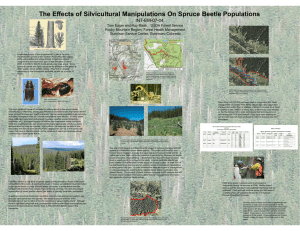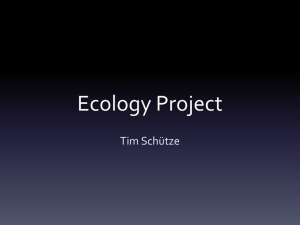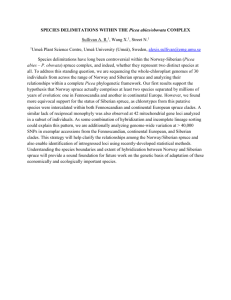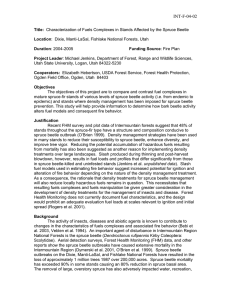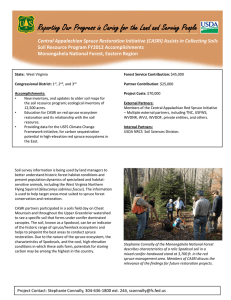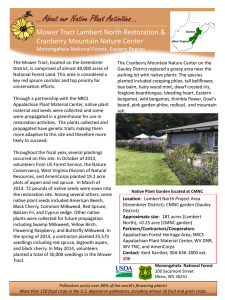TITLE: INT-EM-07-04 LOCATION: DURATION:
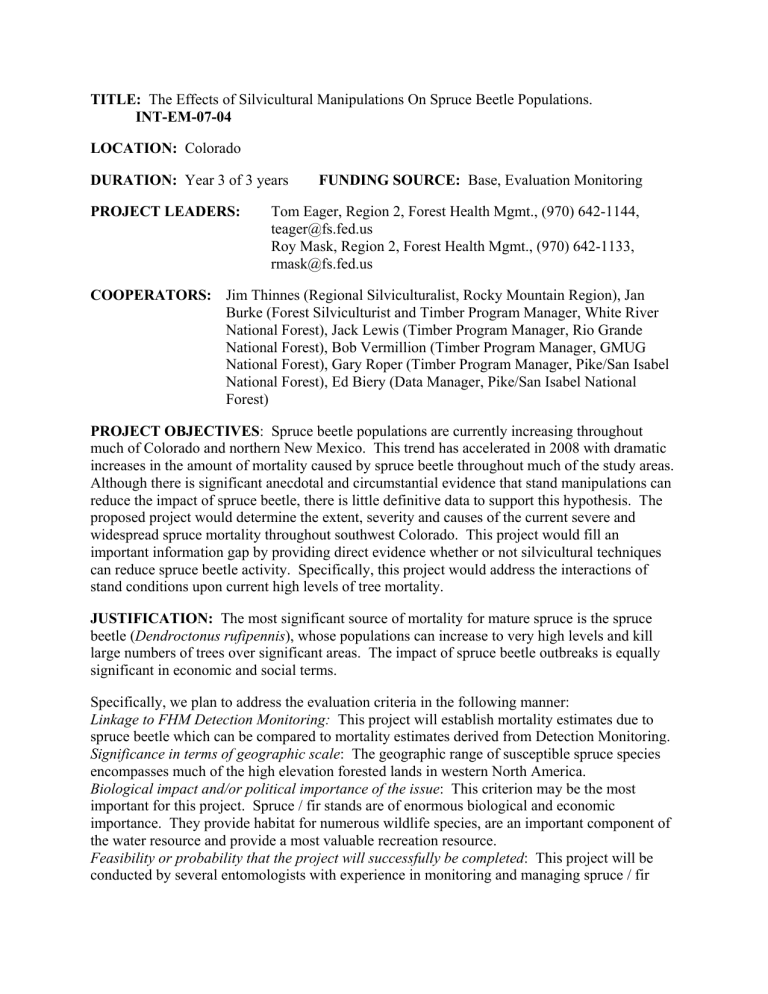
TITLE: The Effects of Silvicultural Manipulations On Spruce Beetle Populations.
INT-EM-07-04
LOCATION: Colorado
DURATION: Year 3 of 3 years FUNDING SOURCE: Base, Evaluation Monitoring
PROJECT LEADERS: Tom Eager, Region 2, Forest Health Mgmt., (970) 642-1144, teager@fs.fed.us
Roy Mask, Region 2, Forest Health Mgmt., (970) 642-1133, rmask@fs.fed.us
COOPERATORS: Jim Thinnes (Regional Silviculturalist, Rocky Mountain Region), Jan
Burke (Forest Silviculturist and Timber Program Manager, White River
National Forest), Jack Lewis (Timber Program Manager, Rio Grande
National Forest), Bob Vermillion (Timber Program Manager, GMUG
National Forest), Gary Roper (Timber Program Manager, Pike/San Isabel
National Forest), Ed Biery (Data Manager, Pike/San Isabel National
Forest)
PROJECT OBJECTIVES : Spruce beetle populations are currently increasing throughout much of Colorado and northern New Mexico. This trend has accelerated in 2008 with dramatic increases in the amount of mortality caused by spruce beetle throughout much of the study areas.
Although there is significant anecdotal and circumstantial evidence that stand manipulations can reduce the impact of spruce beetle, there is little definitive data to support this hypothesis. The proposed project would determine the extent, severity and causes of the current severe and widespread spruce mortality throughout southwest Colorado. This project would fill an important information gap by providing direct evidence whether or not silvicultural techniques can reduce spruce beetle activity. Specifically, this project would address the interactions of stand conditions upon current high levels of tree mortality.
JUSTIFICATION: The most significant source of mortality for mature spruce is the spruce beetle ( Dendroctonus rufipennis ), whose populations can increase to very high levels and kill large numbers of trees over significant areas. The impact of spruce beetle outbreaks is equally significant in economic and social terms.
Specifically, we plan to address the evaluation criteria in the following manner:
Linkage to FHM Detection Monitoring: This project will establish mortality estimates due to spruce beetle which can be compared to mortality estimates derived from Detection Monitoring.
Significance in terms of geographic scale : The geographic range of susceptible spruce species encompasses much of the high elevation forested lands in western North America.
Biological impact and/or political importance of the issue : This criterion may be the most important for this project. Spruce / fir stands are of enormous biological and economic importance. They provide habitat for numerous wildlife species, are an important component of the water resource and provide a most valuable recreation resource.
Feasibility or probability that the project will successfully be completed : This project will be conducted by several entomologists with experience in monitoring and managing spruce / fir
cover types, our primary cooperator is a researcher with numerous publications from similar work.
DESCRIPTION: a. Background : Do silvicultural treatments reduce tree mortality caused by spruce beetle?
While this question has been answered definitively in some bark beetle/host systems (mountain pine beetle/lodgepole pine, for example), information is lacking in the case of spruce / spruce beetles. We propose to measure and monitor stand conditions in areas that have recent spruce beetle activity. Due to a dramatic increase in spruce beetle activity, we have seen some dramatic examples in support of our hypothesis. In many of the untreated stands, spruce beetle activity is resulting in intense mortality, while nearby, recently treated stands have been subject to much less mortality.
Figure 1. A dramatic increase in spruce beetle activity within the study forests is typified by this view on the Rio
Grande National
Forest. This photo shows the impact of spruce beetle on untreated stands in the background, while stands that were treated 30 years ago
(foreground) show little impact. b. Methods: We intend to measure stand parameters of managed spruce stands in order to determine what effect management inputs have on spruce beetle impacts. Managed stands will be compared with unmanaged stands in areas with current and recent spruce beetle activity.
Both unmanaged and managed mature spruce stands will be monitored for degrees and causes of tree mortality. In addition to the activities outline in our original proposal, the Gunnison Service
Center will be conducting QAQC reviews of our contracted field crews. We plan to visit at least
10% of the measured plots in order to assure contract compliance.
Stand Selection: USDA Forest Service data will be used to select stands to be used in the study.
A list of candidate stands will be created on five National Forests based on 2 criteria: at least
50% of the stems are spruce and there is a record of silvicultural manipulation at some point in the past. In addition, we have found that NAIP (National Agriculture Imagery Program) photos have been of great value in determining access and status of candidate stands.
Data Analysis: Determination of which parameters are the most critical in determining resistance to spruce beetle activity will be determined by examining the various factors with a bifurcation or “tree-structuring” process. c.
Products: Field managers are interested in information that supports silvicultural inputs designed to reduce spruce beetle activity. They need “how-to” documentation to achieve these results, but also need documentation of these findings to support NEPA decision documents.
Specific guidelines that will be of interest include: Description of stand characteristics that reduce beetle susceptibility and the silvicultural methods that can (with time) result in stand conditions that resist spruce beetle activity. d. Schedule of Activities:
Year 3: Field data collection will be completed. Final analysis and report writing will commence following data entry. e. Progress/Accomplishments: Spruce beetle activity has accelerated greatly during FY08.
We are able to compare treated and untreated stands and in some cases the differences are striking (see Figure 1). Plot selection went more smoothly than expected due to the complete activities records that we were able to access on each of the Forests. The selection process combined the use of these activities files, stand exam data and the use of NAIP photos. This imagery is available free of charge and has one meter resolution. The discovery of the use of this imagery greatly aided the stand selection process.
Field work has commenced on two (out of five) cooperating Forests. Work on the San Isabel
NF has been completed with 30 stands sampled. Completion of plots on the Rio Grande NF was delayed by the implementation of fire transfer which took money from a contract that was not finalized. The cooperators have been informed that these funds may be restored for the FY09 field season. With full funding in FY09, we will be able to complete the field plot portion of the study. Even if the fire transfer dollars are not restored, our cooperators on the Rio Grande NF have offered to provide field assistance to complete this important project.
Administration
Salary $10,000.
Overhead (15%) $2,925. Procurements
Travel $8,500.
Contracting
Equipment $500.
Supplies $500.
Administration
FY07 Total = $22,425.00
Salary $18,716.
Overhead (15%) $2,817. Procurements
Travel $8,500.
FY08 Total = $33,033
Contracting
Equipment
$2,000.
$500.
Supplies $500.
Administration
Salary
Overhead
$18,716.
(15%)
Travel $8,500.
FY09 Total = $33,033
Contracting $2,000.
Supplies $500.

